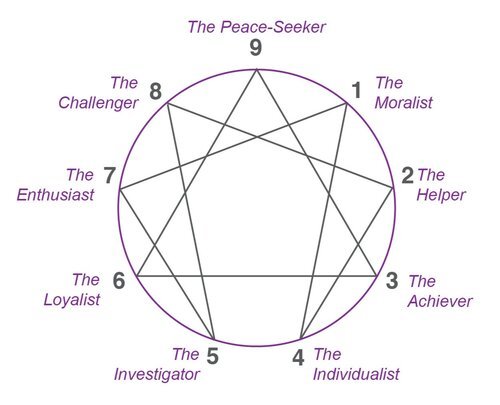INTRODUCTION TO THE ENNEAGRAM
What is the Enneagram?
The Enneagram is a personality typology that sheds light on our inner worlds. It is a tool to understand our insecurities, motivations, and the driving forces behind our decision-making. It helps us to empathize with others so that we can best connect with them, best serve them, and best work with them. The Enneagram has its origins in different wisdom traditions and has been integrated with modern psychology over the last 50 years.
What does the Enneagram teach us that other personality typologies (e.g., Myers-Briggs) do not?
Myers-Briggs (MBTI), as well as many other popular personality typologies, aim to identify behavioral patterns. The Enneagram goes many layers deeper by understanding the fears and motivations behind the behaviors. This is the most powerful piece because if we want to change our behaviors, we must understand the underlying motivations.
How does the Enneagram work?
We start to understand ourselves through the four basic building blocks of the Enneagram that shape our personalities – Levels of Consciousness, Type, Wing, and Instincts.
The Levels of Consciousness is the most important dimension of the Enneagram framework because it makes the framework dynamic and also gives it purpose. Consciousness at its simplest is awareness, and in this context specifically awareness of our inner workings. The more aware, the healthier we are; the less aware, the unhealthier, because that indicates our insecurities are likely in the driver’s seat. The Levels of Consciousness shows us why two people of the same Enneagram Type can behave so differently. It also gives the framework purpose because it shows us a path to growth. Learn more about the Levels of Consciousness.
There are nine basic personality Types on the Enneagram (the name “Enneagram” means nine-pointed figure). Every individual is one of the nine Types. The primary Type is the most essential element of our personality. It is our lens on the world through which all of our thoughts and experiences are filtered.
In addition to the primary Type, each of us has a secondary Type, called a Wing. The Wing is always adjacent to the primary Type.
Therefore, if you are a primary Type 7, you could have either a 6 Wing or 8 Wing. If you are a Type 9, you could have an 8 Wing or 1 Wing, and so on. There are major differences between people of the same Type with a different Wing. The Wing is such a powerful driver that it influences what we want and how we show up more than almost any other factor besides the Type itself. This weighs so heavily on our personality that it even frequently determines whether the Type is introverted or extroverted, and the degree of introversion or extroversion.
We each have a hierarchy of three instinctual urges. That hierarchy further differentiates people of the same Type. The importance of this dimension cannot be overstated. We have found that more conflicts arise due to difference in Instincts than difference in Type.
Can you be more than one Enneagram Type and can your Type change?
According to the framework of the Enneagram, we have only one primary Type and that Type is fixed. That which uniquely makes us who we are throughout our lives is always preserved at the core. How that expresses itself through our behaviors depends on our Level of Consciousness. It will also depend on aspects like our environment, the people we surround ourselves with, and many other external factors. We have the energies of all nine Types in us, and so we naturally relate to all of them. But the most powerful thing is to understand what really makes us tick, pulling the strings on all the other fears and desires we possess.
How can the Enneagram help me?
Each Type comes with its own unique set of motivations and insecurities. When we see and understand the subconscious and unconscious parts of ourselves that are mysterious to even us, we gain a powerful lever to make positive change. What we can see is what we have freedom over. What we cannot see has power over us. When we know what's really going on inside, we begin to see there are viable alternatives to the destructive choices we sometimes make. We also begin to see what's going on inside others, which builds empathy and freedom to act in more thoughtful, beneficial ways. It makes us honest, humble, and sincere in our personal progress, as well as more available to deeply and genuinely connect with others, rather than hiding our vulnerabilities or pushing our viewpoints.
How can understanding the Enneagram improve my relationships?
Each Type speaks a different language. Yet deep down, we all want to be understood and expect people to orient around our language. Knowing the Enneagram intimately empowers us to learn the language of ourselves and others. When we feel the insecurities and pains that others are operating with, along with our own insecurities and pains, it's hard to be hard on people! We start to feel more compassion and understanding. With an understanding of the Enneagram, we come to know what each person is really after at heart and the sincerity of the striving. Even the most perverse behaviors become illuminated as something deeper that's innocent gone wrong. It doesn't mean we condone the behavior. But it does mean we can orient in much wiser ways. This is the best recipe for constructive relationship. It all comes down to understanding.
Learn more at one of our Enneagram workshops or get in touch about private Enneagram coaching (Deep Dives)

